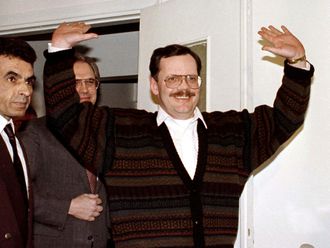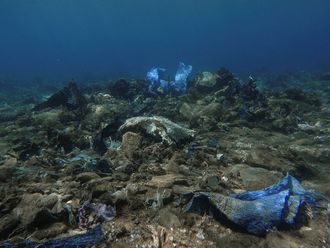Cape Canaveral, Florida: A mysterious space plane is on its way to orbit.
The Air Force launched its unmanned mini-shuttle from Cape Canaveral, Florida, late Wednesday morning. An Atlas V rocket carried it up.
This is the fourth flight for the military research programme, which is shrouded in secrecy. The last X-37B mission lasted close to 675 days and ended with a California touchdown. The Air Force won’t say how long this particular mission will last or where it will end.
The X-37B looks like a miniature version of a Nasa space shuttle. Like the old shuttle, the X-37B launches vertically and lands horizontally, is reusable, and has lots of room for experiments. But no one flies on them, they are operated robotically.
As with the previous flights, the Air Force revealed few details about what the unmanned X-37B spacecraft, which resembles a smaller version of NASA’s retired space shuttles, will be doing.
“The test mission furthers the development of the concept of operations for reusable space vehicles, and fine-tunes technical parameters for an affordable, reusable space vehicle,” said Capt. Christopher M. Hoyler, a spokesman for the Air Force.
Boeing has built two X-37B spacecraft for the Air Force. The first launched in April 2010, setting off speculation over the vessel’s purposes. Some suggested that the craft had something to do with space weapons, which the Pentagon denied. It landed in December that year. The second orbiter was sent up from March 2011 to June 2012. The first craft made a second flight, launching in December 2012 and returning 674 days later, in October 2014.
The Air Force was not saying which of the two was packed inside an Atlas 5 rocket on the launch pad at Cape Canaveral, Florida.
“We are excited about our fourth X-37B mission,” Randy Walden, the director of the Air Force Rapid Capabilities Office, said in a statement released last month. “With the demonstrated success of the first three missions, we’re able to shift our focus from initial checkouts of the vehicle to testing of experimental payloads.”
A four-hour launch window opened at 10.45am on Wednesday. Forecasts indicated a 60 per cent chance of favourable weather.
One of the experiments the Air Force has talked about is an improved version of an electric thruster. Unlike conventional thrusters employing chemical reactions, electric thrusters are more efficient, accelerating charged ions through electric fields.
Electric thrusters are common on commercial satellites, but the Air Force needs more powerful propulsion. Aerojet Rocketdyne has built thrusters for three military satellites that run at five kilowatts, or about four times the power of those on commercial satellites. The thruster on the X-37B is a modified version, intended to improve performance, although it still generates less than a tenth of a pound of thrust.
“But it does it very, very efficiently from a fuel standpoint,” said Fred C. Wilson, director of business development at Aerojet Rocketdyne. “It’s a higher-power, higher-performance device.”
Nasa, which collaborated on the development of the thruster, hopes that similar technology can be used to propel cargo ships to Mars, part of an eventual mission to send astronauts there. Last month, the space agency selected Aerojet Rocketdyne to develop and test a 100-kilowatt electric thruster.
Nasa is also taking advantage of this X-37B flight to test how almost 100 materials react to the harsh conditions of space, like the barrage of radiation and swings of temperature the craft will experience while passing between the day and night sides of the Earth for at least 200 days.
“It’s just sitting there and letting the environment hit it,” said Miria Finckenor, a materials engineer at NASA’s Marshall Space Flight Centre in Huntsville, Alabama. She is the principal investigator for the experiment, which is housed in the space plane’s cargo bay.
The materials to be tested include thermal coatings to keep spacecraft components within a certain range of temperatures, clear materials under consideration for lighter windows on NASA’s Orion crew capsule and ink to make sure that markings on parts do not fade away.
Nasa previously tested more than 4,000 samples outside the International Space Station, but it is difficult to carve out time during spacewalks to set up and retrieve the experiments. “This opportunity presented itself, and we just needed to take advantage of it,” Finckenor said.
The information gleaned from such experiments helps engineers choose materials for spacecraft components like antennas.
In addition to the space plane, the Atlas 5 rocket will give 10 tiny satellites known as CubeSats a ride to space. The CubeSats will be deployed to test technologies like new propulsion and communication systems.
One of the CubeSats is LightSail, developed by the Planetary Society, a non-profit that promotes space exploration. On launching, it is about the size of a loaf of bread, but after a month of testing, it is to deploy four 13-foot booms and unfurl four triangular pieces of Mylar to act as a sail, propelled by sunlight. For this test flight, the orbit will be too low for the force of photons to overcome atmospheric drag, and the satellite is expected to fall out of the sky within a few days.
A second LightSail, scheduled to lift off next year on a Falcon Heavy rocket from Space Exploration Technologies Corp., or SpaceX, is to be sent high enough to demonstrate controlled solar sailing in orbit. The second LightSail is already built, but the society is raising additional money through a Kickstarter campaign for education and promotion.












